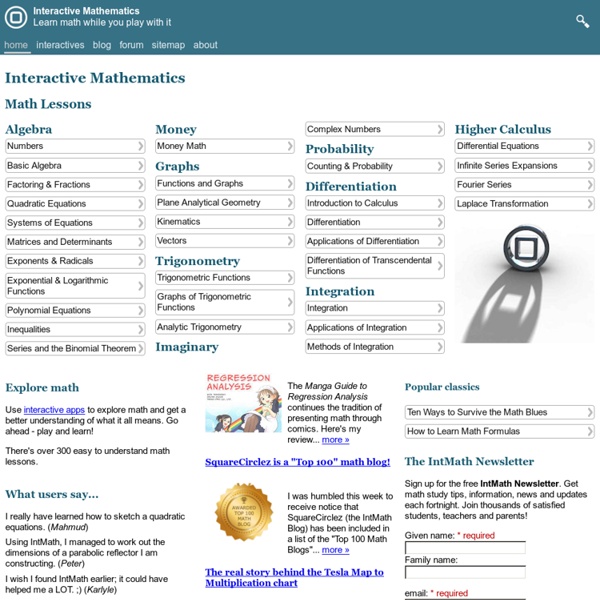



Grid Paper PDFs - Nightly Free Online Graph Paper / Grid Paper PDFs Downloadable and very printable, I find these PDFs extremely useful. Tip number one! Though I do return the correct header for a PDF, sometimes Explorer gets confused when downloading... So if you're running Windows, you may need to right-click a link and choose "Save link to disk".
Parabolas Parabolas(This section created by Jack Sarfaty) Objectives: Lesson 1: Find the standard form of a quadratic function, and then find the vertex, line of symmetry, and maximum or minimum value for the defined quadratic function. Lesson 2: Find the vertex, focus, and directrix, and draw a graph of a parabola, given its equation. Lesson 3: Find the equation of our parabola when we are given the coordinates of its focus and vertex.
Interactive GeoGebra Student Worksheet on Triangle Centers Geometry teachers! This is for you! Explore this wonderfully color-coded interactive diagram with your students. It includes lots of juicy questions at the bottom to help your students investigate the ins and outs of triangle centers and what they are used for in practical situations. The only thing it assumes is that you’ve explained the definitions of medians, altitudes, perpendicular bisectors, and angle bisectors. Statistica Online Textbook "Thank you and thank you again for providing a complete, well-structured, and easy-to-understand online resource. Every other website or snobbish research paper has not deigned to explain things in words consisting of less than four syllables. I was tossed to and fro like a man holding on to a frail plank that he calls his determination until I came across your electronic textbook...You have cleared the air for me. You have enlightened.
Secondary Maths resources collections Skip to main content Jobs TES the largest network of teachers in the world My TES Complex numbers This is an introduction to complex numbers. It includes the mathematics and a little bit of history as well. It is intended for a general audience. The necessary background in a familiarity with ordinary real numbers (all positive and negative numbers and zero) and algebra. In one section some background in trigonometry is needed as indicated with the symbol. OCSD Interactive Games Design Your Own Games Pre-Made Games Matching Game Directions- In this game you can match up words.
Online texts Professor Jim Herod and I have written Multivariable Calculus ,a book which we and a few others have used here at Georgia Tech for two years. We have also proposed that this be the first calculus course in the curriculum here, but that is another story.... Although it is still in print, Calculus,by Gilbert Strang is made available through MIT's OpenCourseWare electronic publishing initiative. Here is one that has also been used here at Georgia Tech. Linear Methods of Applied Mathematics, by Evans Harrell and James Herod. Yet another one produced at Georgia Tech is Linear Algebra, Infinite Dimensions, and Maple, by James Herod.
Mathematics Skoool.co.uk A fantastic free resource to support maths and science at Key Stages 3 and 4. There are wonderful interactive activities and study notes. Pupils can download the resources for offline use. Interactive whiteboard resources too. Superb! MathSphere - Resources MathSphere Ltd P.O. Box 7533WeymouthDT4 4FPtel: 01273 782 786 fax: 01273 785 550 MathSphere Free Resources for children aged 5 to 11 These links lead to a wide variety of free maths pages which are all in Flash paper or pdf format, allowing for easy printing out.
Learning the Habits of Mind that Enable Mathematical and Scientific Behavior Math/Science Matters: Resource Booklets on Research in Math and Science Learning Booklet 2 Issues of Instructional Technique in 9 Mental Math Tricks Math can be terrifying for many people. This list will hopefully improve your general knowledge of mathematical tricks and your speed when you need to do math in your head. 1. Multiplying by 9, or 99, or 999 Multiplying by 9 is really multiplying by 10-1. So, 9×9 is just 9x(10-1) which is 9×10-9 which is 90-9 or 81. Elo rating system Arpad Elo, the inventor of the Elo rating system The Elo rating system is a method for calculating the relative skill levels of players in such competitor-versus-competitor games as chess. It is named after its creator Arpad Elo, a Hungarian-born American physics professor. The Elo system was invented as an improved chess rating system and is also used in many other games. It is also used as a rating system for multiplayer competition in a number of video games,[1] and has been adapted to team sports including association football, American college football, basketball, Major League Baseball, and esports.
Chess News - Arpad Elo and the Elo Rating System By Daniel Ross Indiana University of Pennsylvnia Math 563 – Mathematical Statistics I Fall 2007 Ask any United States Chess Federation (USCF) member about his or her "Elo;" you will likely get an immediate and accurate response. Now ask that same USCF member where the term "Elo" comes from. Something along the lines of, "I forget... someone told me what it stands for once, but I can't remember" is more likely than the correct response.